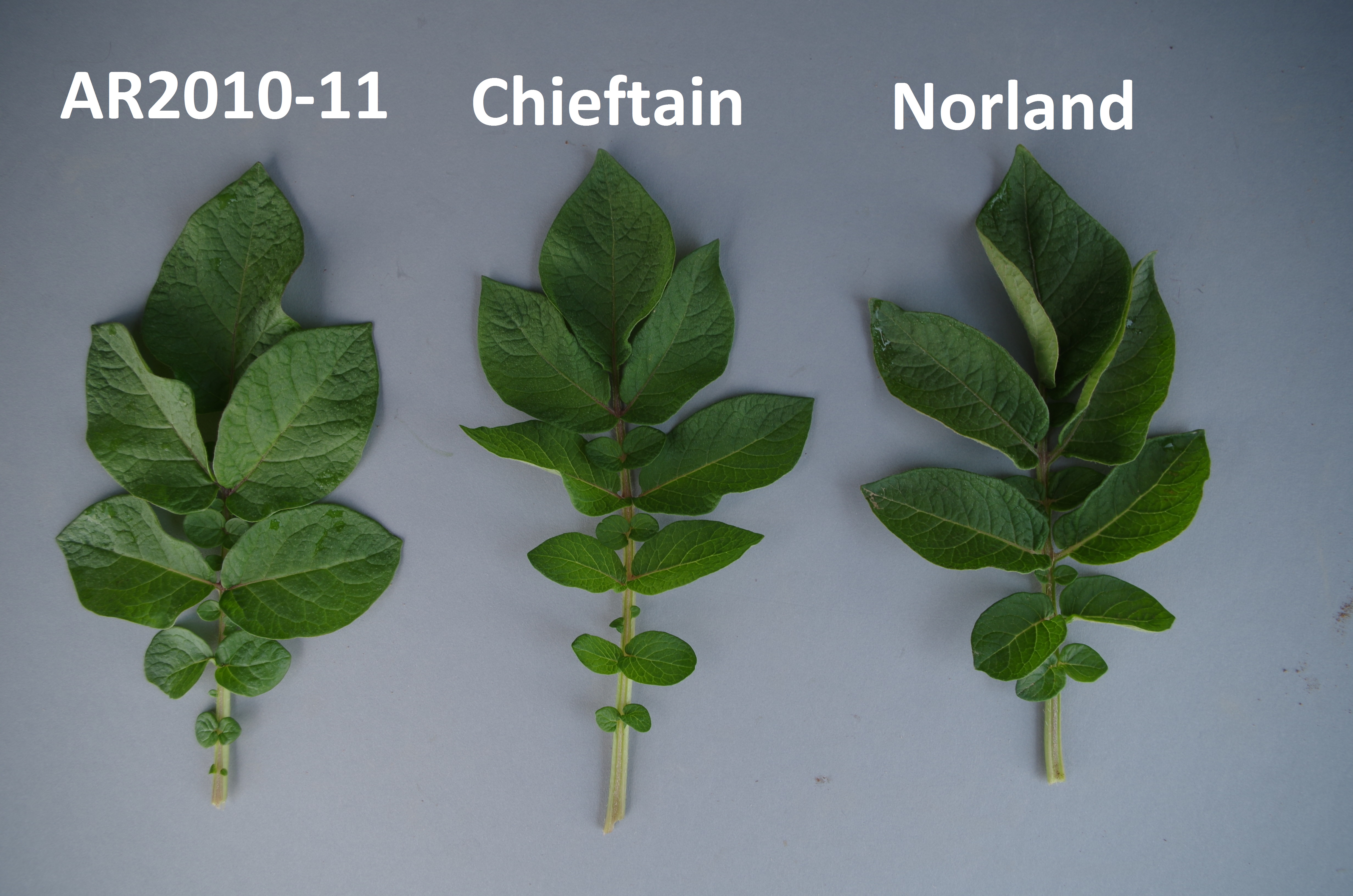AAC Fushia
| Denomination: | 'AAC Fushia' |
|---|---|
| Previously Proposed Denomination: | 'AR2010-11' |
| Botanical Name: | Solanum tuberosum |
| Applicant/Holder: |
Agriculture & Agri-Food Canada, Fredericton Fredericton Research and Development Centre 850 Lincoln Road, P.O. Box 20280 Fredericton, New Brunswick E3B 4Z7 Canada |
| Breeder: |
Agnes Murphy, Agriculture & Agri-Food Canada, Fredericton, New Brunswick |
| Agent in Canada: |
Agriculture & Agri-Food Canada Office of Intellectual Property and Commercialization c/o Shannon Whyte 107 Science Place Saskatoon, Saskatchewan S7N 0X2 Canada Tel: (204) 999-9887 |
| Application Date: | 2015-04-26 |
| Provisional Protection:: | 2015-04-26 |
| Application Number: | 15-8614 |
| Grant of Rights Date: | 2016-11-08 |
| Certificate Number: | 5366 |
| Grant of Rights Termination Date: | 2036-11-08 |
Variety Description
Varieties used for comparison: 'Chieftain' and 'Norland'
Summary: The lightsprout of 'AAC Fushia' is small whereas the lightsprout of 'Chieftain' is medium in size and that of 'Norland' is medium to large. In relation to the base, the tip of the lightsprout of 'AAC Fushia' is small whereas the tip of the lightsprout of the reference varieties is medium in size. The habit of the tip of the lightsprout of 'AAC Fushia' is closed whereas the habit is intermediate to open for 'Chieftain' and intermediate for 'Norland'. The extent of anthocyanin colouration of the stem is high and distributed along the entire stem for 'AAC Fushia' whereas the extent is medium along the entire stem of 'Chieftain' and low at the base of the stem only for 'Norland'. The upper side of the leaf of 'AAC Fushia' is medium green whereas the upper side of the leaf of the reference varieties is dark green. The intensity of anthocyanin colouration of the midrib on the upper side of the leaf is strong for 'AAC Fushia' whereas the intensity is medium for 'Chieftain' and absent or very weak for 'Norland'. The extent of anthocyanin colouration of the peduncle is high for 'AAC Fushia' whereas the extent is medium for the reference varieties. The shape of the tuber of 'AAC Fushia' is round whereas the shape of the tuber of the reference varieties is oval to oblong. The flesh of the tuber of 'AAC Fushia' is cream coloured whereas the flesh of the reference varieties is white.
Description:
LIGHTSPROUT: small, spherical shape, medium number of root tips, short lateral shoots
LIGHTSPROUT BASE: strong intensity of anthocyanin colouration, medium proportion of blue in anthocyanin colouration, medium density of pubescence
LIGHTSPROUT TIP: small in relation to base, closed habit, weak intensity of anthocyanin colouration, dense pubescence
PLANT: foliage structure is leaf type where foliage is closed and stems are not or hardly visible, semi-upright growth habit, matures mid-season
STEM: high extent of anthocyanin colouration along entire stem
LEAF: outline is small to medium size, openness is intermediate, medium presence of secondary leaflets, medium green on upper side, high extent and strong intensity of anthocyanin colouration of mid-rib on upper side, absent or very low frequency of coalescence of terminal and lateral leaflets
SECOND PAIR OF LATERAL LEAFLETS: medium size, leaflet is narrower than long
LEAFLET: weak waviness of margin, medium depth of veins, medium glossiness of upper side, blade at apical rosette is pubescent
INFLORESCENCE: medium frequency per plant, small to medium size
PEDUNCLE: high extent of anthocyanin colouration
FLOWER BUD: high extent of anthocyanin colouration
COROLLA: small to medium size, medium extent and strong intensity of anthocyanin colouration on inner side, medium proportion of blue in anthocyanin colouration on inner side
TUBER: round shape, cream coloured flesh
TUBER EYE: medium to deep, red at base
TUBER SKIN: red
Origin & Breeding History: 'AAC Fushia' (experimental designations '15005-07' and 'AR2010-11') originated from a cross conducted in Fredericton, New Brunswick, in 2002, between a selection designated 'N1700-8' , as the female parent, and the variety 'Chieftain', as the male parent. The breeding technique used was controlled fertilization of emasculated flowers. From the resulting progeny, 'AAC Fushia' was selected in 2005 during the first field generation for its adaptation to Canadian growing conditions and potato production systems, tuber type and fresh market potential.
Tests & Trials: The comparative trial for 'AAC Fushia' was conducted during the 2015 growing season at Agriculture and Agri-Food Canada's Fredericton Research and Development Centre in Fredericton, New Brunswick. The trial consisted of 2 replicates with 30 plants per variety in each replicate, grown in two 7.5 metre length rows spaced 90 centimetres apart. Plants were spaced 25 centimetres apart in the row. The measurements were taken from 10 plants, or parts of plants, of each variety.
Click on image for larger view

Potato: 'AAC Fushia' (left) with reference varieties 'Chieftain' (centre) and 'Norland' (right)
Click on image for larger view

Potato: 'AAC Fushia' (left) with reference varieties 'Chieftain' (centre) and 'Norland' (right)
Click on image for larger view

Potato: 'AAC Fushia' (left) with reference varieties 'Chieftain' (centre) and 'Norland' (right)
- Date modified: